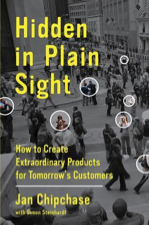
Hidden in Plain Sight
I’ve long been of the view that user experience methodology is useful well beyond the design phase of a web based proposition, product or service – it can and should be part of the strategy development process which proceeds it. The techniques used by user experience designers, which range from workshops to interviews to card sorting exercises are just as useful when utilised by management consultants, process designers, pr and marketing professionals, in human resources contexts such as change management, etc etc.
I’ve just come across a useful excerpt from HIDDEN IN PLAIN SIGHT: How To Create Extraordinary Products for Tomorrow’s Customers by Jan Chipchase and Simon Steinhardt on the use of user experience methodology in a corporate context. They write:
If there’s such a thing as a default framework in corporate research, it’s the customer journey map, which provides detailed information about each event in a customer’s typical day, diagrams how she moves from one event to another, and identifies all the touchpoints where she may use the product or service we’re designing. Customer journey maps tend to be very precise in their documentation and technical in their appearance–many boxes connected by many lines. They’re useful for building a basic level of understanding, and certainly no one would accuse them of being arbitrary, but reading them can sometimes feel like a mechanical process.
In addition to customer journeys, which tend to start at the trigger point and end with resolution, Chipchase and Sthenhardt reveal, in the excerpt, a less widely used technique, threshold mapping:
Threshold mapping allows us to map out “default” conditions–the normal state a person experiences a majority of the time (for example, most people feel clean enough throughout the day that they won’t drop whatever they’re doing and hop in the shower if it’s available)–and then understand what happens when a person crosses the line into an alternative condition. Often, the feelings that people experience as they approach or cross a threshold lead them to think and act differently.